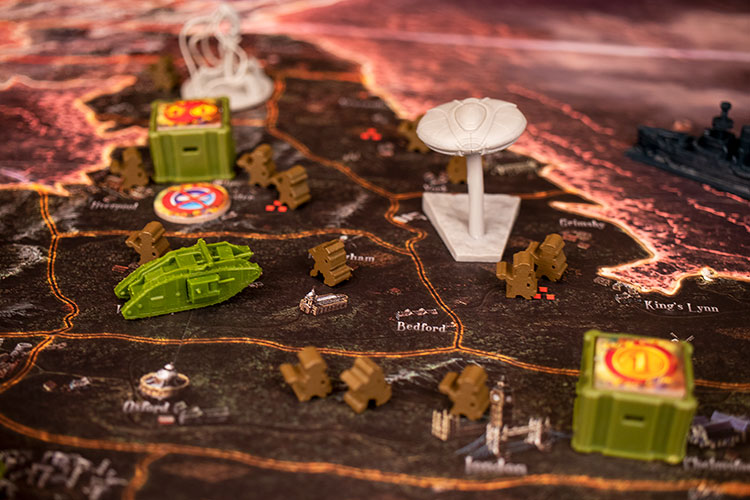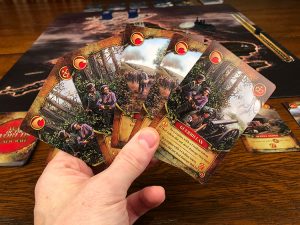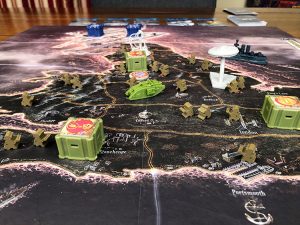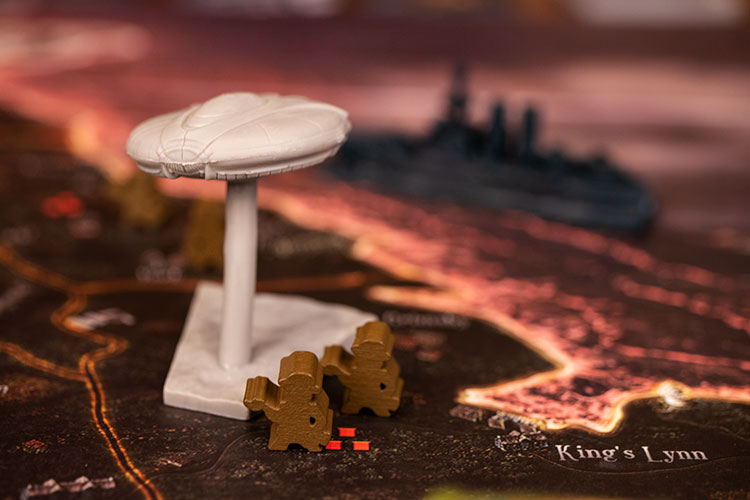 When you say War of the Worlds, people immediately think of the 2005 Tom Cruise movie that critics described as “Not terrible”…OK, maybe not. I’d bet dollars to doughnuts that it’s actually the 1938 radio broadcast narrated by one Orson Wells that some people mistook as real. Well, that or maybe the book. Regardless, English author H. G. Wells science fiction story about the day the tripods came has been a source for countless hours of entertainment across a variety of mediums. And today, it enters the board game realms (again).
When you say War of the Worlds, people immediately think of the 2005 Tom Cruise movie that critics described as “Not terrible”…OK, maybe not. I’d bet dollars to doughnuts that it’s actually the 1938 radio broadcast narrated by one Orson Wells that some people mistook as real. Well, that or maybe the book. Regardless, English author H. G. Wells science fiction story about the day the tripods came has been a source for countless hours of entertainment across a variety of mediums. And today, it enters the board game realms (again).
War of the Worlds: The New Wave is an asymmetrical, two player board game published by Grey Fox Games. Designed by Denis Plastinin, a group of humans in the U.K. struggle to outlast the overwhelming assault from the Martians.
Gameplay Overview:
War of the Worlds is a deck building game that follows in the footsteps of many of its predecessors, yet still throws in a few of its own unique wrinkles.
Each game is setup the same, with 30 human civilians on the board and a couple of aliens in Scotland. Starting with the alien player, each player takes a turn playing or discarding all 5 cards in their hand. Cards come in three varieties: building cards, unit cards, or action cards.

Building cards used to construct structures that grant the owner a unique power. Once built, the card is removed from the game. Unit cards allow the player to recruit a unit, or if its already on the board, move or attack with it. Usually, attack cards have a few options, a regular attack and a more powerful one by removing the card from the game. Finally, action cards do a variety of things such as granting a unit a movement or special power or providing currency to buy new cards.
Money earned on a turn can be spent to buy cards from your market row. Any cards bought go into your discard pile to be used on a future turn (except for the aforementioned building cards).
Like in standard deck building games, at the end of your turn all cards played or in your hand are sent to your discard pile and you draw a hand of five cards.
The game ends with an Alien win when all civilian units are wiped out, or a human win when the Alien player has sustained 30 points of damage.

Game Experience:
Halfway through my first game I was ready to call War of the Worlds a broken and unplayable mess. Seriously, I was the humans and the aliens were steamrolling me. I was trying to figure out if we were either doing something wrong or how this game got through playtesting. Yet as the game rolled on, things started to balance out. I got some army and naval units on the board, a few forts and bunkers, and suddenly that tripod wasn’t so fierce. While I did end up losing the game, it was literally only by 1 turn. Not so broken after all, I guess.

One of the reasons that the aliens feel so powerful is due to the asymmetrical nature of the gameplay. The human forces are constantly going to take a beating and be ground to pulp. What’s interesting is that the alien units and buildings never are removed from play. All damage done to an alien unit or building is tracked on a single damage track. Do 30 damage and drive off those pesky aliens. It can be all to one unit or spread across multiple.
This helps create an atmosphere for the human player of feeling outmatched and overwhelmed—but not in a bad way. It somehow feels really thematic to the source material. It’s been a long time since I’ve read one of the War of the Worlds books, but they were never about the humans kicking the alien’s butt. It was always about them scraping by, trying to survive. Which the game does a great job of replicating. The action is tense, tight, and frequent.

So, while I was ready to toss this game in the bin halfway through my first play, it ended up being a really tight contest through all our plays. Not a single game ended up with a runaway leader, and the more you play a faction, the more you being to understand its strategies. As a human player, I realized it’s all about taking the right opportunities and thinning out your deck. Unlike most deck building games, it’s really easy to remove a lot of the cards from the game, and with the bonus of extra damage when you do so. So, players must balance when they want to dump a card, vs future uses of it. Yet if you can get the right cards in a thin deck, the humans can definitely put the aliens on the ropes.
My biggest worry with War of the Worlds is going to be from its replay value. The game has a standard setup, and I worry that things will feel a bit samey after enough plays. The aliens always in the north and tend to gobble up some civilians before the humans can really get any kind of defense going. I would have much preferred some kind of variable setup or modular board. And, as a human, I almost always have chewed through most of the market deck in one play. Although I should note that our review copy did ship with the Irish Sea expansion in the box. So not all is lost. That expansion comes with a sideboard and some more cards.
I should also note that there were a few component issues. The rulebook could have been laid out better and had some typos. The gameboard also felt overly dark, which made it hard to make out some of the civilian starting locations. Nothing game breaking, but the production values could have used a bit more TLC.

Final Thoughts:
War of the Worlds: The New Wave is a good take on the “deck builder with a board” genre. It also does a good job of being thematic and using its source material well. The aliens feel powerful and bloodthirsty, while the humans are constantly on their heels, plinking away at the aliens hoping to do just enough damage to drive them away.
The game is easy to learn (although the rulebook could definitely have been better), has some quick turns with minimal downtime, and I really dug the asymmetrical gameplay. My only question is if War of the Words: The Next Wave has enough staying power to be engaging after repeated plays with the same cards and same setup. Time will tell on that one. Yet for those looking for a fun, two-player asymmetrical deck builder with some unique wrinkles, this one is definitely worth trying out.
Final Score: 3.5 Stars – A solid deck builder that’s easy to learn and uses its theme well.
 Hits:
Hits:
• Tight, balanced gameplay
• Uses its theme well
• Fun asymmetrical gameplay has a lot of tense moments
Misses:
• Some production issues
• Could have used a variable setup to help replay value.























